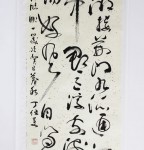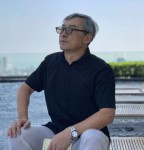Ouyang Xun (Chinese: 歐陽詢; Wade–Giles: Ouyang Hsun) (557–641), courtesy name Xinben (信本), was a Confucian scholar and calligrapher of the early Tang Dynasty. Chinese Calligrapher, Politician, one of the Four Great Calligraphers of Early Tang Dynasty (Chu Suiliang 褚遂良, Yu Shinan虞世南, Xue Ji薛稷),He was born in Hunan, Changsha, to a family of government officials; and died in modern Anhui province, to a family of government officials; and died in modern Anhui province.the Founder of Ou Style
Ouyang Xun's calligraphy, largely kaishu(regular script), was known for its rigorous and grand strokes as well as its unique order and structure, and was called "Ou Style" by later generations. His kai shu works include Jiuchenggong Liquan Ming, and the most famous kingship works are Mengdian Tie and Zhanghan Tie. Besides being an expert in kasha and kingship, Ouyang also wrote excellent lishu(official script).
Several of his kasha works were seen as the best of theTang Dynasty. As the later generations found out, his kaishu had a certain order or formula in both its strokes and structure, which was easy for a novice to learn.
As early as in theSui Dynasty, Ouyangs calligraphy was widely known, and by the Tang Dynasty, as both the man and his calligraphy got older, had attained a high degree of perfection. However, Ouyang was not content with the achievements and continued practicing.
One day, during an outing with his friends, Ouyang came upon a stele inscribed by Suo Jing (a famous calligrapher of the Jin Dynasty), and felt the inscription was really mediocre after several look at it. However, upon second thought, he believed there must be something outstanding about the stele, since Suo was hailed as a great calligrapher. With this idea in mind, He stood for a long while in front of the stele, had a careful look into it and discovered the sparkling points about it. He went on to explore the stele for another three days, and finally realized the secret of using awriting brush, hence further perfecting his calligraphy.
He was a talented student who read widely in the classics. He served under the Sui Dynasty in 611 as Imperial Doctor. He served under the Tang Dynasty as censor and scholar at the Hongwen Academy. There he taught calligraphy. He was a principal contributor to the Yiwen Leiju.
He became the Imperial Calligrapher and inscribed several major imperial steles. He was considered a cultured scholar and a government official. Along with Yu Shinan and Chu Suiliang he became known as one of the Four Great Calligraphers of the Early Tang Dynasty.
| < Prev | Next > |
|---|
- 2020-06-24 - 千古赤诚一军师 | 诸葛亮《出师表》
- 2020-06-07 - Ding Shimei——Chinese calligrapher, 丁仕美芸術略歴
- 2012-08-08 - 百年忆启功:学为人师,行为世范
- 2011-05-06 - KUSHO: Calligraphy in The Sky, Shinichi Maruyama, Janpan Modern Art
- 2011-05-04 - Wang Xizhi, The Sage of Chinese Calligraphy
- 2011-01-07 - 文徵明行书《明妃曲》
- 2010-12-20 - Philosophy About Chinese Calligraphy
- 2010-08-10 - Laozi (Lao-tzu, fl. 6th C. BCE)
- 2010-08-08 - The Dragon's Embrace - China's Soft Power Is a Threat to the West
- 2010-06-04 - Aesthetics & Philosophy About Chinese Calligraphy














